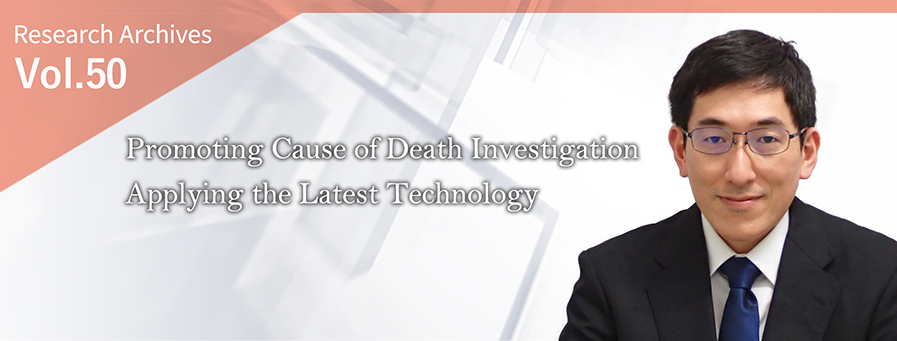
Department of Forensic Medicine, Graduate School of Medicine, Hokkaido University
MATOBA Kotaro M.D., Ph.D. (Social Medicine)Social
Medicine
- [Academic & Professional Experience]
-
- 1999: Graduated from Hokkaido Asahikawahigashi High School.
- 1999-2005: M.D. course, Hokkaido University School of Medicine
- 2005-2007: Ph.D. course, Hokkaido University Graduate School of Medicine
- 2007-2018: Assistant Professor, Department of Forensic Medicine, Hokkaido University Graduate School of Medicine
- 2018-2023: Lecturer, Department of Forensic Medicine, Hokkaido University Graduate School of Medicine
- 2023-present: Professor, Department of Forensic Medicine, Hokkaido University Graduate School of Medicine
Contributing to community safety and public health by elucidating the cause of death
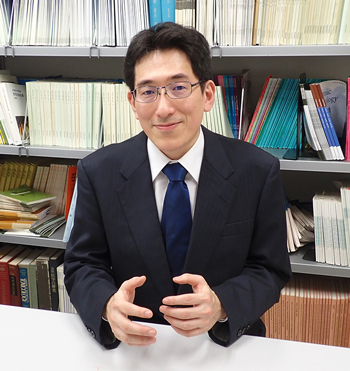
The history of this department began on May 26, 1923, when Dr. Kumao Yamagami was appointed as the first professor. Since then, the department has developed under Dr. Shokichi Ueno, Dr. Ginjiro Saito, Dr. Toru Suzutani, Dr. Takehiko Takatori, and Dr. Koichi Terazawa, and after 100 years, Dr. Kotaro Matoba was appointed as the seventh professor on March 1, 2023. The first to fourth generations of professors hailed from other universities, followed by Professor Tatehiko Takatori (5th), Professor Koichi Terazawa (6th), and Professor Kotaro Matoba (7th), all of whom were from Hokkaido University. Currently, the department comprises 16 members: one professor, one lecturer, one assistant professor, and one technical staff member; three research fellows, one medical assistant technician, one technical assistant, five administrative staff members, as well as one specially appointed assistant professor physician and one dentist from the Center for Cause of Death Investigation, who conduct daily work and research.
The field of forensic medicine is facing a nationwide shortage of human resources. In Hokkaido, there are only five physicians specializing in forensic medicine. The number of forensic physicians has continually declined from the seven when Professor Matoba was a graduate student 20 years ago. In recent years, the number of unnatural deaths has rapidly increased with the rising number of fatalities, with 9,000 unnatural deaths occurring annually in Hokkaido. The number of judicial autopsies has increased three- to four-fold due to an increase in the autopsy rate of unnatural deaths as a result of a 2014 Cabinet decision to promote the investigation of cause of death by government policy. This has dramatically increased the burden on forensic physicians. Since 2017, when the number of judicial autopsies peaked in Japan, the department has also performed nearly 400 autopsies yearly, although this number has fluctuated. Professor Matoba says, “The number of unnatural deaths is expected to increase further in the future due to the aging of the population and the increasing unmarried rate. The training of forensic physicians is an urgent issue, as more forensic physicians are expected to play an active role in the future.”
In response to recent advances in analytical instruments, research in forensic medicine has focused on post-mortem imaging using multi-slice CT equipment and rapid and highly sensitive drug toxicology tests using mass spectrometry. The department has also introduced such equipment and used it to conduct research. These instruments are not only applied to work and research activities related to forensic medicine, but also to various other specialized fields and clinical departments of Hokkaido University Hospital, including post-mortem imaging, medical safety activities, emergency medicine, surgical training, contributing to the development of Hokkaido University through this wide range of applications.
In terms of forensic practice, as mentioned above, the number of forensic autopsies has been increasing in recent years, presently exceeding 1,000 every year, led by a record number of 1,370 in 2022. Professor Matoba says, “The impact of COVID-19 has been particularly significant. It seems that the increasing rate has grown steeper since the pandemic.”
The department also contributes to public health in the region by diagnosing cases of unnatural death on autopsy as those related to COVID-19 (approx. 100 cases) and streptococcal toxic shock syndrome (3 cases) based on CT imaging, biochemical tests, and antigen/PCR tests, and reporting these to the related public health centers and other institutions.
Research related to cause of death investigation using state-of-the-art equipment
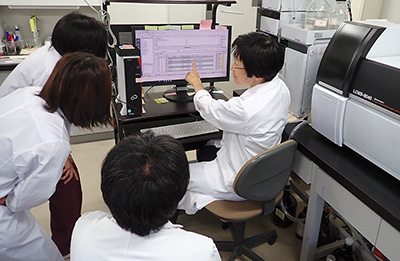
For the examination of medicinal toxicants related to the determination of cause of death, the department has introduced state-of-the-art techniques such as high-performance liquid chromatograph mass spectrometer (LC-MS), gas chromatograph mass spectrometer (GC-MS), and energy dispersive X-ray spectrometer (EDX). LC-MS detects a wide range of high- to low-polarity substances including psychotropic drugs, stimulants, and other medicinal toxicants, and quantifies them as necessary. Three models of the instrument have been installed to accommodate a variety of specimens and applications, and a system has been constructed to allow direct analysis of organs and other tissues from liquids such as blood and urine. GC-MS can analyze substances of very low polarity that LC-MS cannot analyze. It is particularly adept at analyzing volatile substances such as alcohol and detecting toxic gases. EDX, which has recently been introduced, is a device specialized in inspecting and analyzing metals. Professor Matoba says, “Although there have not been many cases, some murders (including attempted murders) over the past 30 years have involved toxic metals that are not analyzed or measured with general drug toxicology tests, and this device was installed to use in such cases.”
Using these chemical analyzers, the department has been developing and applying methods for the analysis and measurement of thiosulfate, which is related to a diagnosis of hydrogen sulfide poisoning, and is also studying the relationship between post-mortem elapsed time and short-chain fatty acids. The methods of medicinal toxicology analysis have demonstrated their capabilities not only in the field of forensic research, but also internal medicine, pharmacology, and emergency medicine at the university, and many results have been achieved through collaborative research.
In post-mortem imaging, which forms another department pillar, a dedicated 16-row multi-slice CT system, and a workstation for image analysis play a vital role in determining the cause of death when it cannot be confirmed by external findings. In the study of post-mortem imaging, efforts are being made to develop CT imaging methods to evaluate brain hemorrhage in case of decomposed bodies with a long post-mortem time, to conduct research on pulmonary findings using post-mortem CT, and to develop analysis methods for various objective evaluations. In particular, regarding sudden death with a background of sleep apnea, which is Professor Matoba’s life’s work, post-mortem images of the oral and pharyngeal regions are used for evaluation and particular attention is paid to the shape of the internal surface of the skull.
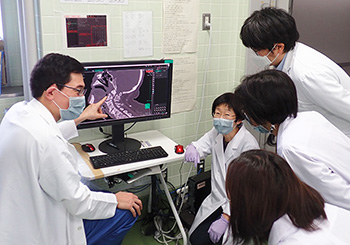
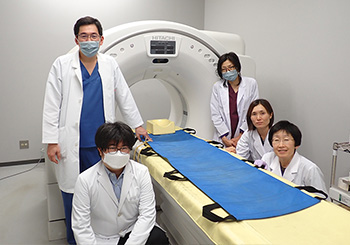
(Interviewed in September 2024)
A diverse group of members working hard in practice and research
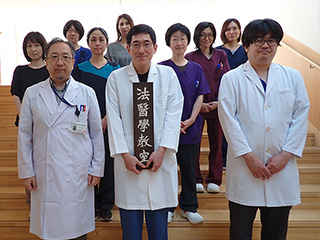
The staff members in the department come from a wide variety of backgrounds. In addition to a professor with a background in forensic medicine, there are pathologists (2), a doctor of dental surgery, veterinarians (3), and clinical laboratory technicians, as well as a technician with a background in bioengineering and an organic chemist with a background in science who seemingly have no connections with forensic medicine. Although they all have different backgrounds and specialties, they all share the same ambition: to get to the bottom of the cause of death. Professor Matoba says, “We do our work and research daily while immersed in the joy of creating new ideas and technologies from different pieces of specialized knowledge.”


